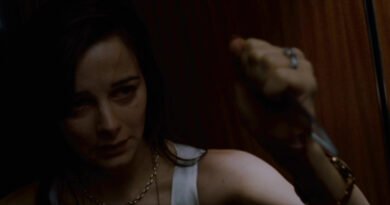Livid (2011): A Surreal French Gothic Nightmare
Title: Livid (2011) (Livide)
Writer(s): Alexandre Bustillo, Julien Maury
Director: Alexandre Bustillo, Julien Maury
Main Cast: Actor (Character): Chloé Coulloud (Lucie), Catherine Jacob (Mrs. Jessel), Félix Moati (William), Jérémy Kapone (Ben), Béatrice Dalle (The Witch)
Synopsis
Set in a quiet coastal town in France, Livid follows Lucie, a young trainee caregiver who begins work at the eerie, decaying home of a comatose former dance instructor, Mrs. Jessel. Rumoured to be hiding a treasure somewhere inside the house, Lucie returns at night with her boyfriend and his brother to search for it. However, they unwittingly disturb something ancient and vengeful, unleashing a nightmare of supernatural terror, surreal imagery, and dark fairy-tale horror.
What Works
Livid is a visually striking and atmospheric horror film that leans heavily into Gothic and fairy-tale influences. The cinematography is rich with haunting detail, capturing the dilapidated beauty of the Jessel mansion and imbuing it with a dreamlike, nightmarish quality.
Bustillo and Maury, best known for their brutal debut Inside, shift gears here to deliver something more ethereal and fantastical, yet still steeped in dread. The use of practical effects, subtle CGI, and ornate set design contributes to the film’s immersive and eerie tone.
The narrative blends themes of grief, innocence, and the corruption of beauty, evoking comparisons to Suspiria and the films of Jean Rollin. Chloé Coulloud delivers a sympathetic and understated performance as Lucie, grounding the film’s surreal turns with emotional honesty.
The second half, while less grounded, ventures boldly into the surreal and mythic, offering striking visuals and bizarre, otherworldly horror that rewards viewers open to abstraction.
What Doesn’t Work
Livid may alienate viewers who prefer linear, clearly explained narratives. The plot grows increasingly opaque as it delves into its supernatural mythology, offering more questions than answers. Some characters are underdeveloped, and the film doesn’t always provide a strong emotional anchor amidst its imagery.
Pacing can also be uneven. The early tension builds slowly and deliberately, but the shift to surreal horror may feel abrupt or disjointed. Additionally, the film’s blend of styles and genres—gothic, fairy tale, gory horror—can be confusing for those expecting a more cohesive tone.
Final Thoughts: Does It Hold Up?
Yes, especially for fans of arthouse horror and European genre cinema. Livid is a bold, if flawed, attempt at blending beauty with terror, and its visual ambition and stylistic confidence set it apart from more conventional horror films. It’s a film that lingers less for its scares than for its dreamlike descent into dark fantasy.
Who Would Enjoy This Episode?
- Fans of atmospheric, art-house horror.
- Viewers who appreciate Gothic fairy tales and surreal narratives.
- Admirers of films like Suspiria, The Others, or The Orphanage.
- Horror fans open to mood and aesthetics over jump scares.
Who Might Not Enjoy It?
- Viewers looking for a straightforward or clearly explained plot.
- Those who prefer fast-paced, visceral horror.
- Audiences sensitive to ambiguous storytelling and stylistic abstraction.
Final Verdict
Livid is a visually captivating and emotionally eerie exploration of loss, transformation, and the supernatural. Though not without flaws, its ambition and style make it a memorable entry in modern French horror—ideal for those willing to embrace horror as dreamlike, poetic nightmare.




